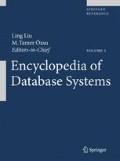Access this chapter
Tax calculation will be finalised at checkout
Purchases are for personal use only
Recommended Reading
Cicerone S. and Di Felice P. Cardinal directions between spatial objects: the pairwise-consistency problem. Inf. Sci., 164(1–4):165–188, 2004.
Clementini E. and Billen R. Modeling and computing ternary projective relations between regions. IEEE Trans. Knowl. Data Eng., 18(6):799–814, 2006.
Freksa C. Using orientation information for qualitative spatial reasoning. In Proceedings of COSIT’92, LNCS, vol. 639, 1992, pp. 162–178.
Goyal R. Similarity Assessment for Cardinal Directions Between Extended Spatial Objects. PhD Thesis, Department of Spatial Information Science and Engineering, University of Maine, April 2000.
Hernández D. Qualitative Representation of Spatial Knowledge, LNCS, vol. 804. Springer, Berlin, 1994.
Ligozat G. Reasoning about cardinal directions. J. Visual Lang. Comput., 9:23–44, 1998.
Mukerjee A. and Joe G. A qualitative model for space. In Proc. 7th National Conf. on AI, 1990, pp. 721–727.
Navarrete I., Morales A., and Sciavicco G. Consistency checking of basic cardinal constraints over connected regions. In Proc. 20th Int. Joint Conf. on AI, 2007, pp. 495–500.
Papadias D. Relation-based representation of spatial knowledge. PhD Thesis, Department of Electrical and Computer Engineering, National Technical University of Athens, 1994.
Peuquet D.J. and Ci-Xiang Z. An algorithm to determine the directional relationship between arbitrarily-shaped polygons in the plane. Pattern Recognit, 20(1):65–74, 1987.
Skiadopoulos S. and Koubarakis M. Composing cardinal direction relations. Artif. Intell., 152(2):143–171, 2004.
Skiadopoulos S. and Koubarakis M. On the consistency of cardinal directions constraints. Artif. Intell., 163(1):91–135, 2005.
Skiadopoulos S., Giannoukos C., Sarkas N., Vassiliadis P., Sellis T., and Koubarakis M. Computing and managing cardinal direction relations. IEEE Trans. Knowl. Data Eng., 17(12):1610–1623, 2005.
Skiadopoulos S., Sarkas N., Sellis T., and Koubarakis M. A family of directional relation models for extended objects. IEEE Trans. Knowl. Data Eng., 19(8):1116–1130, 2007.
Author information
Authors and Affiliations
Editor information
Editors and Affiliations
Rights and permissions
Copyright information
© 2009 Springer Science+Business Media, LLC
About this entry
Cite this entry
Skiadopoulos, S. (2009). Cardinal Direction Relationships. In: LIU, L., ÖZSU, M.T. (eds) Encyclopedia of Database Systems. Springer, Boston, MA. https://doi.org/10.1007/978-0-387-39940-9_45
Download citation
DOI: https://doi.org/10.1007/978-0-387-39940-9_45
Publisher Name: Springer, Boston, MA
Print ISBN: 978-0-387-35544-3
Online ISBN: 978-0-387-39940-9
eBook Packages: Computer ScienceReference Module Computer Science and Engineering

